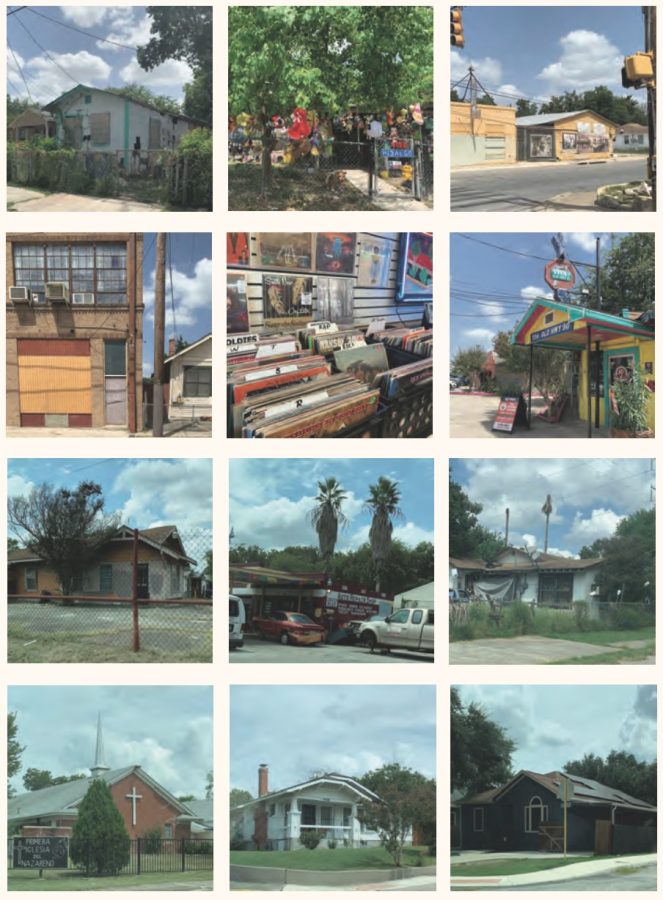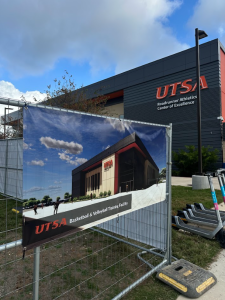Social contract between UTSA and the Westside encourages community engagement
Photo courtesy of Nicole Chavez/Urban Future Lab
A composite photo from Dr. Petrov’s seminar class documenting the existing landscape on the Westside.
September 20, 2022
The Casita Project is the latest initiative to come out of the Urban Future Lab (UFL), a think tank and teaching lab founded by UTSA Associate Professor Dr. Antonio Petrov. Started in 2016, the UFL is housed at the Klesse College of Engineering and Integrated Design.
In 2021, Dr. Petrov led a multidisciplinary team of interns in conjunction with UTSA Vice President for University Relations, Teresa Niño, in developing a research initiative “to propose a strategic plan that outlines possible future relations between UTSA and the Westside,” according to the strategic plan for the project. Dr. Petrov was selected as a Next-Gen Faculty Leadership Fellow, and The Casita Project was born out of Dr. Petrov’s fellowship and a special topics course he was teaching at the time.
Those interns were: Kelsey Brown, who graduated from UTSA with a master’s in architecture and a certificate in historic preservation; Luis Escalante, a master’s student in the urban and regional planning program; Nicole Chavez, a graduate student at St. Mary’s University, studying public administration who also works as the public affairs coordinator for the UFL. A fourth intern, Karla Ruiz, was also a part of the team — unfortunately, she was unable to make it for the interview.
Chavez spoke about the historical and cultural significance of the casitas.
“We call them casitas, but more formally, they’re known as Accessory Dwelling Units — or ADUs,” Chavez said. “They’re really characteristic in San Antonio’s housing landscape. They are something we see naturally occurring here in San Antonio.”
Chavez described the projected future of the casita in San Antonio.
“On the Westside … the casitas, they could support families with residual income. The casitas could help homeowners gain additional income and also establish those ties with the university, with the [university] students, in the form of a ‘social contract,’” Chavez said. “They’re really a long-term economic development strategy.”
For this project, the casita would act as an alternative housing option for students taking classes at the Downtown campus — which will inevitably expand. It is a way to approach incremental growth in housing available to students who would otherwise need to commute from elsewhere in San Antonio while also avoiding the need for large high-rise housing complexes.
The fact that the team is multidisciplinary speaks to the power of diversity in research such as urban development. Escalante spoke to the lengths met to ensure diversity.
“I think this project … what we ended up with really couldn’t have been done in just a group of architects, public policy students or urban planning students,” Escalante said. “[The project] incorporates design, the use of public space, zoning and land use [and] I’m pretty happy with what we came up with so far.”
Brown added that each intern brought their own set of skills to the table.
“Everyone of us comes from a different background. Coming into it, Luis had all of the insight into the planning, the zoning and things that in architecture we don’t really go into, even though it’s such a big part of what we do — it impacts what we do,” Brown said.
Furthermore, Chavez discussed the importance of a centralized, multidisciplinary approach to all projects at the Urban Future Lab.
“With all of our projects, we really see [an] importance in interdisciplinary thinking. Bringing people in that represent all different sides of a project. We also like to experiment with formats of dialogue. We have a lot of public events and conversations … we characterize our thinking as having no box. We see ourselves as a nexus,” Chavez said.
In discussing the community’s role in The Casita Project, Brown described the work being done in this first phase and how community engagement was shaped.
“Our goal with the first round of getting this strategic document together was just to have something solid to present to the community. [But] it wasn’t without community input,” Brown said. “We looked to existing reports from NALCAB … and from information that was already out there to inform [us] kind of where to take the project. Based on that, we wanted to get something solid together to take and get community feedback and involvement for the next stage[s].”
Additionally, Escalante described the specifics of the National Association for Latino Community Asset Builders (NALCAB) report, filed jointly with UTSA in 2019.
“ [NALCAB] came out with an impact report in collaboration with UTSA in 2019. And that report was doing an impact analysis on the Westside on UTSA’s proposed campus expansion [and] what impacts that would have on the community,” Escalante said.

UTSA is in the midst of a campus master plan for expansions of both the Main and Downtown campuses. With that rapid expansion comes the worry of gentrification — a process that often occurs within urban development. Brown described the importance of the NALCAB report in addressing these types of concerns.
“Yeah, absolutely. That was a big part of the NALCAB report. Identifying the risk that the Westside community faces, while also providing some recommendations that were really core to the research that we did that followed,” Brown said. “Managing the factors that drive housing costs, preserving existing affordable housing stock, implementing customer protection and fraud prevention efforts and boosting the income of existing neighborhood residents.”
In talking about using the project as a means of preserving the existing history of the Westside — one that is rich in culture and activism — Brown spoke about the urgency of keeping that history intact.
“That’s kind of like the crux of it,” Brown said. “It’s already happening, looking at how the community can shape the future of development in their neighborhood. What we proposed was the idea of more incremental growth. Being able to have the university be a partner to the Westside … at a very local, grassroots level.”
Public stewardship for a project such as this is an essential pillar in shaping a cohesive initiative. Finally, Escalante spoke about the future of projects that could happen under the umbrella of The Casita Project and its tenant program.
“In our document, and this would be a phase two or phase three-step or something where faculty or students would be in the actual community doing community projects,” Escalante said.
Brown noted that the tenant program comes back to the community.
“All of this is about community engagement and the connection and partnership between UTSA and the Westside … being good neighbors, being good stewards to each other,” Brown said.
For more information on the Urban Future Lab, check out their website urbanfuturelab.com. Additional details on the Casita Project can also be found on their website.







